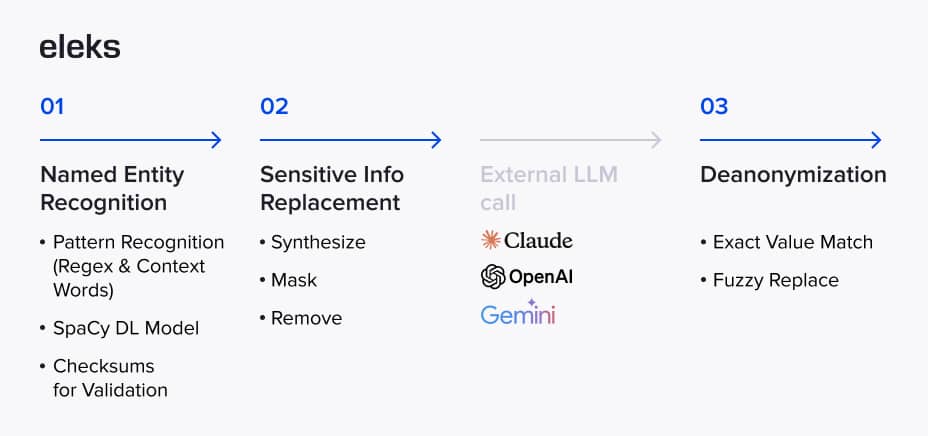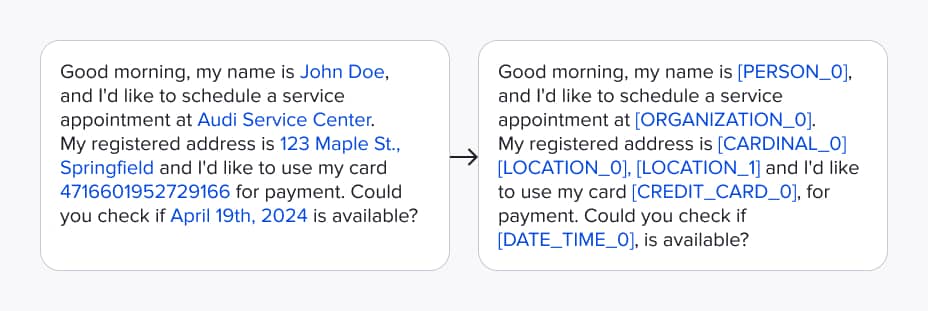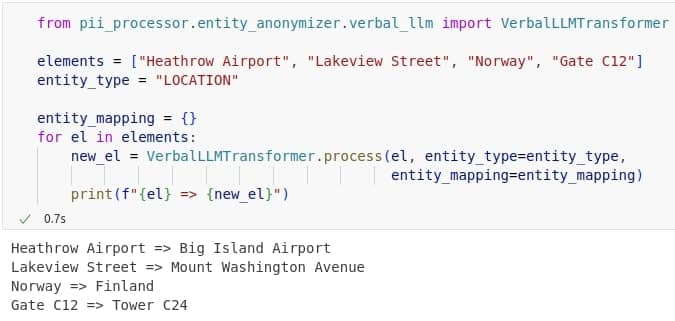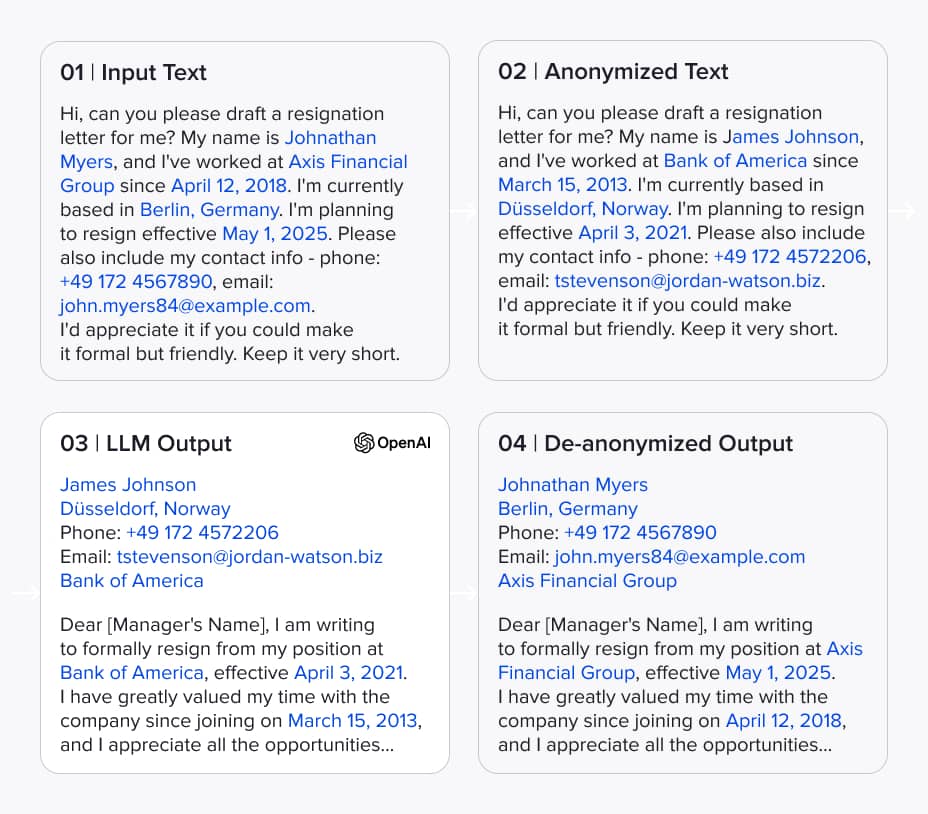
It's no longer a question of whether using LLMs has become a common practice, particularly due to their powerful optimization capabilities. As the AI development field is constantly evolving and companies will continue to adopt LLMs into their workflows, an important question arises: what happens to user data once it's no longer handled locally? Most widely used LLMs operate as black-box models, raising concerns about whether they use user data for training purposes. In practice, while the user's input isn't used for full-scale training, it can still be accessed for limited purposes like model refinement or human review.
A more significant risk is that once this information enters the LLM's pipeline, users have no visibility into where their data is stored, who has access to it, or whether it might be exposed to third parties. These risks have gained significant attention in recent years, creating security guidelines designed for AI systems. One of the most well-known examples of security guidelines is the OWASP Top 10 for LLM Applications. It highlights the common risks like leaking sensitive information, tricking the model with harmful inputs, or using unsafe add-ons. Additionally, OWASP emphasizes the importance of input validation and data sanitization to protect against these vulnerabilities.
Anonymizing data before it reaches LLM: a practical approach
In response to challenges related to the use of sensitive data by LLMs, ELEKS’ data science team developed a local, offline data de-identification tool designed to protect sensitive, confidential, personal identifying information before it reaches an external model. The tool is implemented as a Python package and can be easily integrated into existing workflows. This module is already in active use across several of our internal and client-facing projects, particularly, where deploying large-scale models locally isn't feasible. This tool can be a practical solution for businesses dealing with tight infrastructure budgets, struggling with the limits of lightweight models, or working with highly confidential data. Integrating our data anonymization services allows teams to strike the right balance between productivity and responsible data handling.
However, while spotting sensitive data is common, true anonymization is still a challenge. Many tools are great at finding and tagging personal data, but struggle when it comes to generating realistic, context-aware replacements. Some tools use fake data generators like Faker, which work offline but often ignore the original formatting or lose important context. Others try to solve the problem by sending each sensitive value independently to an external language model to generate replacements, which negates the core objective of protecting user privacy. We weren't trying to reinvent the wheel, so we decided to combine the most effective parts of existing solutions and add the missing pieces they often lack.
- Creating contextually relevant substitution, data masking and removing original data are the three main ways of data anonymization.
- ELEKS’ solution doesn't just mask your sensitive data it creates realistic replacements that keep the original context and meaning.
- Our tool offers end-to-end data anonymization of different data types, enabling secure use of LLMs with the ability to restore original data when needed.
The anatomy of effective de-identification: key components and techniques
In this section, we'll go over the key parts of the ELEKS' data anonymization solution, outline the main challenges, and show how our approach tackles them.

Technical architecture of the anonymization solution
When a user submits text for anonymization, it goes through two main stages:
- Recognition of the named entities
- Replacement of those entities using a selected anonymization strategy.
The process begins with an analyzer that is responsible for detecting potentially sensitive data within the input text. Besides personally identifiable information (PII) such as names and dates, the analyzer can detect a wider range of entities, including addresses, company names, web identifiers, and various types of numerical data, such as cardinals and ordinals. In total, it supports the recognition of around 30 distinct entity types. This component is built on top of the Presidio framework, which combines deep learning-based named entity recognition (NER), regex matching, and context-based enhancement. We've combined and configured its core capabilities to better handle real-world inputs:
- NER: We use spaCy's transformer-based en_core_web_trf model (a fine-tuned RoBERTa). After evaluating alternatives like Stanford's deidentifier, Stanza, and Flair, we found that spaCy offered the best balance of speed and entity coverage;
- Regex: In addition to Presidio's built-in patterns, we introduced custom recognizers to detect a wider range of phone numbers, numeric values (in both digit and word forms), and address formats.
- Context enhancement: To improve confidence scoring, we used spaCy's word stemming and added our parameters to weigh the surrounding context and boost precision.

All data presented is fictional, with randomly generated names and values that have no connection to specific individuals or institutions.
Data anonymization techniques
Once the sensitive data has been identified, the next step is to replace it with alternative values directly within the text. Depending on the use case, this can be done in one of three ways:
- by generating a contextually relevant replacement,
- masking the entity with its type and a unique identifier,
- removing the entity entirely.
Data masking and removing the entity entirely are relatively straightforward approaches. Therefore, in the following paragraphs, we'll focus on the first approach and explain how context-aware replacements are generated.

All data presented is fictional, with randomly generated names and values that have no connection to specific individuals or institutions.
In the contextual replacement approach, entities are processed individually, relying on the information embedded within them, such as their type, format, or cultural and geographical context. In some cases, the entity's structure is enough to create a realistic replacement. For example, data elements like national ID numbers, passport codes, or IP addresses follow a predefined format, so they can be replaced with random but similar-looking values.
We used the Faker framework, which has built-in tools for generating fake but believable data. However, other entities, such as credit card numbers, IBANs, and phone numbers, need more careful handling to keep important details. For these, we implement custom transformers: the generated credit card matches the original issuer and passes checksum validation; IBAN codes follow the correct country format and are kept valid; phone numbers preserve their structure by replacing only the last few digits.

All data presented is fictional, with randomly generated names and values that have no connection to specific individuals or institutions.
Similarly, dates require a separate handling strategy due to the various formats they can appear in. While existing tools can detect and extract dates from text, none provide a clean way to infer and preserve the original format, such as whether the date includes time, uses ordinals, or follows a specific value order (e.g., day-first vs. month-first). To address this, we implemented a custom handler that first analyses and stores the input format before generating a synthetic replacement. The replacement itself is produced by applying controlled shifts: times are adjusted by a random number of seconds or minutes within a small range, dates are shifted by a few weeks to ensure the month changes while keeping the seasonal context, and years are randomly changed within a range of one to five years.

All data presented is fictional, with randomly generated names and values that have no connection to specific individuals or institutions.
Another category we handle separately is numeric values, which are recognized as entities such as CARDINAL, ORDINAL, PERCENT, MONEY, and QUANTITY. These values can appear in various formats: may be written as digits or words, expressed as cardinals or ordinals, and represented as integers or floating-point numbers. To accurately reproduce these formats in anonymized output, we use regex-based pattern matching to identify their structure by preserving details such as precision and the use of separators like commas or periods. The anonymized value is then generated by adjusting the original using a scaling factor within a ±10% range (from 0.9 to 1.1). For cases where a more controlled output is needed, a custom operation, such as multiplication or addition with a fixed operand, can also be applied to ensure consistent transformations.

All data presented is fictional, with randomly generated names and values that have no connection to specific individuals or institutions.
The most challenging part of anonymization was replacing free-text values like names of people, companies, addresses, or buildings. At first, we tried breaking these entities into individual words and finding similar ones using word embeddings like FastText. However, this method often produced unnatural results, as breaking values into separate words ignored their meaning as a whole. So, we decided to give a try with small language models to generate replacements in a smarter way. We tested several options, including LLaMA, Phi, distilled GPTs, and Qwen. LLaMA and Qwen gave the best results, while LLaMA struggled with personal names, likely due to safety filters. Qwen performed better overall, especially in its quantized version. We chose Qwen2.5 0.5B (Q8_0, ~675 MB) for its good balance of quality and speed.




All data presented is fictional, with randomly generated names and values that have no connection to specific individuals or institutions.
Additionally, finding the right prompt for these models wasn’t straightforward. We tried many different options, changing how we described the entity, whether to include examples, and how much guidance to give the model. Some of the early prompts led to problems, such as repeating parts of the original text or producing unrelated results. Eventually, we found a short and clear prompt that provided stable and useful outputs without revealing sensitive information.

All data presented is fictional, with randomly generated names and values that have no connection to specific individuals or institutions.
Data decoding process
By integrating all components described above, we developed a system that produces high-quality anonymized text while preserving structure and meaning. But one important piece was still missing: deanonymization. To make the anonymized text usable for tasks like analysis or transformation, we developed two methods: one based on exact matching, and another that supports fuzzy matching to handle slight changes within entities. With these in place, the system offers a full end-to-end data anonymization pipeline. The image below illustrates the complete workflow, showing detected entities, their replacements, and how users can copy anonymized text into an LLM, retrieve results, and deanonymize them if needed.

All data presented is fictional, with randomly generated names and values that have no connection to specific individuals or institutions.
Conclusions
As AI becomes more integrated into our lives and business processes, data anonymization tools create a bridge between privacy requirements and technological advancement.
Our data anonymization tool tries to balance data privacy with AI utility. It replaces sensitive information with contextually suitable alternatives created locally, without relying on external services or cloud-based models. This way, users can fully leverage AI tools without exposing confidential data.
There’s still room for improvement. Our team plans to improve the handling of gender consistency during person name synthesis, improve entity recognition on noisy or informal input, support cross-entity conditions where values are dependent on one another, and develop specialized modes for medical texts and patent or IP-related documents where domain-specific patterns and sensitivities need special attention.

FAQs
Data anonymization capabilities cover removing or replacing private identifiers with fake identifiers to protect users' privacy.
One can anonymize data by removing or changing any information that identifies individuals. This makes it impossible to link data back to a person. Common methods for doing this include generalization, suppression, perturbation, and creating synthetic data.
Let's look at a dataset from hospital research as an example of anonymized data. We need to change personal details like names, addresses, exact birthdates, and medical record numbers to random values. We can shorten zip codes and group ages into ranges, like 30-39, instead of showing specific years.
Data anonymization has several challenges despite its advantages. Re-identification is possible when anonymized data is linked to external datasets, and the process can diminish data utility and disrupt important relationships between data points. There is no universal standard for what constitutes "anonymous" data, and techniques that work for one dataset may fail for another. Effective data anonymization process often requires specialized expertise, and even well-executed methods may not protect against advanced inference attacks, potentially creating a false sense of security.
Data masking is a subset of a broader category of data protection known as data anonymization. In addition to masking, anonymization can be done by generating replacements or completely removing data.
Rearranging original values in ways that differ from their original form and replacing the original data with artificial data are all ways to achieve anonymization.
Related Insights









Inconsistencies may occur.
The breadth of knowledge and understanding that ELEKS has within its walls allows us to leverage that expertise to make superior deliverables for our customers. When you work with ELEKS, you are working with the top 1% of the aptitude and engineering excellence of the whole country.

Right from the start, we really liked ELEKS’ commitment and engagement. They came to us with their best people to try to understand our context, our business idea, and developed the first prototype with us. They were very professional and very customer oriented. I think, without ELEKS it probably would not have been possible to have such a successful product in such a short period of time.

ELEKS has been involved in the development of a number of our consumer-facing websites and mobile applications that allow our customers to easily track their shipments, get the information they need as well as stay in touch with us. We’ve appreciated the level of ELEKS’ expertise, responsiveness and attention to details.

